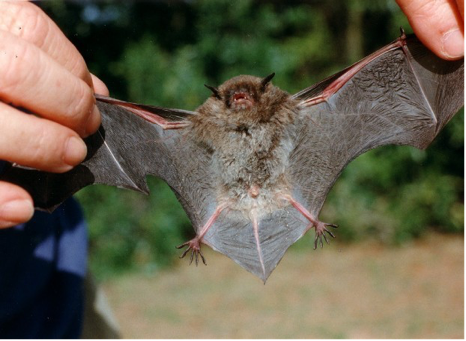In 2009 the NSW Planning Assessment team was charged with assessing the proposed Riverside Development extending from Myall Quays to Toonang Drive in Tea Gardens. They identified this tiny bat as one of 3 endangered and 12 vulnerable species living within this area, which regardless of their conservation concerns and recommendations is soon to be developed.

.Threatened by land clearing, mining and destruction of roosting sites the large-footed micro-bat or Myotis is sparsely dispersed across coastal New South Wales
This 5 cm long mouse like creature, with rounded ears, is a fishing-bat, inhabiting wetland areas and riversides in mainly flat or undulating terrain, living in tree hollows, under bridges and in storm water channels and caves.
These micro bats feed on aquatic insects and small fish using echolocation to locate their dinner. Their disproportionally large clawed feet are well suited to catching their prey as they rake the water.
Like all bats the hind limbs are orientated so that the knees point backwards when they are bent, while the bottom of their feet face forwards.
Bats are the only group of mammals that are specifically adapted for flight. The female Myotis can give birth to three babies a year. The young are extremely helpless, born hairless, they hold onto their mother’s belly feeding on milk from nipples located under the mother’s armpit.
There are two types of bats – Micro Bats and Mega Bats.
Many micro bats species are the insect terminators along our coast. As our climate warms and mosquito viruses move south micro bats are a valuable asset for mosquito control.
There are approximately 70 species of bats in Australia, with 43 species identified as being locally or nationally threatened. 35 of these threatened species are micro bats.
At night around our wetland areas, you may be lucky enough to spot a large-footed Myotis at work fishing but remember it is a rare sight.
Lee Anderson Myall Koala and Environment Group
2018
ref: Wikipedia and Dept. of Environment and Heritage Protection
This 5 cm long mouse like creature, with rounded ears, is a fishing-bat, inhabiting wetland areas and riversides in mainly flat or undulating terrain, living in tree hollows, under bridges and in storm water channels and caves.
These micro bats feed on aquatic insects and small fish using echolocation to locate their dinner. Their disproportionally large clawed feet are well suited to catching their prey as they rake the water.
Like all bats the hind limbs are orientated so that the knees point backwards when they are bent, while the bottom of their feet face forwards.
Bats are the only group of mammals that are specifically adapted for flight. The female Myotis can give birth to three babies a year. The young are extremely helpless, born hairless, they hold onto their mother’s belly feeding on milk from nipples located under the mother’s armpit.
There are two types of bats – Micro Bats and Mega Bats.
Many micro bats species are the insect terminators along our coast. As our climate warms and mosquito viruses move south micro bats are a valuable asset for mosquito control.
There are approximately 70 species of bats in Australia, with 43 species identified as being locally or nationally threatened. 35 of these threatened species are micro bats.
At night around our wetland areas, you may be lucky enough to spot a large-footed Myotis at work fishing but remember it is a rare sight.
Lee Anderson Myall Koala and Environment Group
2018
ref: Wikipedia and Dept. of Environment and Heritage Protection

